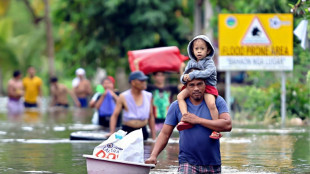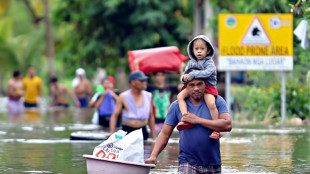
-
 UN warns of rough winter ahead for refugees
UN warns of rough winter ahead for refugees
-
Brazil's 'action agenda' at COP30 takes shape

-
 Trump threatens $1 billion action as BBC apologises for edit error
Trump threatens $1 billion action as BBC apologises for edit error
-
Sinner dominates injury-hit Auger-Aliassime in ATP Finals opener

-
 Trump hails Syria's 'tough' ex-jihadist president after historic talks
Trump hails Syria's 'tough' ex-jihadist president after historic talks
-
Syria's ex-jihadist president meets Trump for historic talks

-
 Top US court hears case of Rastafarian whose hair was cut in prison
Top US court hears case of Rastafarian whose hair was cut in prison
-
US mediator Kushner and Netanyahu discuss phase two of Gaza truce
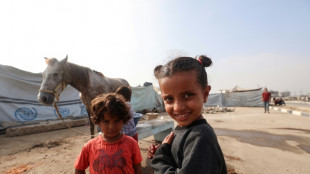
-
 End to US government shutdown in sight as Democrats quarrel
End to US government shutdown in sight as Democrats quarrel
-
Trump threatens air traffic controllers over shutdown absences

-
 US to remove warnings from menopause hormone therapy
US to remove warnings from menopause hormone therapy
-
UK water firm says 'highly likely' behind plastic pellet pollution incident
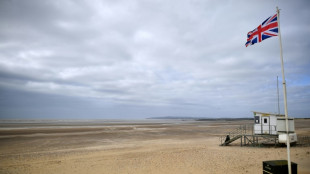
-
 Syria's ex-jihadist president holds historic Trump talks
Syria's ex-jihadist president holds historic Trump talks
-
End to record-long US government shutdown in sight

-
 France's ex-leader Sarkozy says after jail release 'truth will prevail'
France's ex-leader Sarkozy says after jail release 'truth will prevail'
-
Atalanta sack coach Juric after poor start to season

-
 Trump threatens $1 billion action as BBC apologises for speech edit
Trump threatens $1 billion action as BBC apologises for speech edit
-
Gattuso wants 'maximum commitment' as Italy's World Cup bid on the line

-
 Indian capital car blast kills at least eight
Indian capital car blast kills at least eight
-
Deadly measles surge sees Canada lose eradicated status

-
 Brazil's Lula urges 'defeat' of climate deniers as COP30 opens
Brazil's Lula urges 'defeat' of climate deniers as COP30 opens
-
Strangled by jihadist blockade, Malians flee their desert town
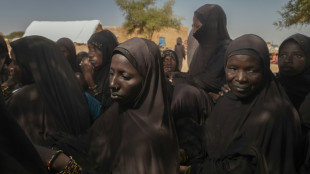
-
 US Supreme Court declines to hear case challenging same-sex marriage
US Supreme Court declines to hear case challenging same-sex marriage
-
'Fired-up' Fritz sees off Musetti in ATP Finals

-
 Injured Courtois set to miss Belgium World Cup qualifiers
Injured Courtois set to miss Belgium World Cup qualifiers
-
Bulatov, pillar of Russian contemporary art scene, dies at 92

-
 Fritz sees off Musetti in ATP Finals
Fritz sees off Musetti in ATP Finals
-
US strikes on alleged drug boats kill six more people

-
 Sarkozy released from jail 'nightmare' pending appeal trial
Sarkozy released from jail 'nightmare' pending appeal trial
-
COP30 has a mascot: the fiery-haired guardian of Brazil's forest
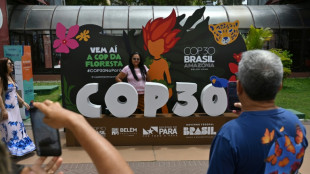
-
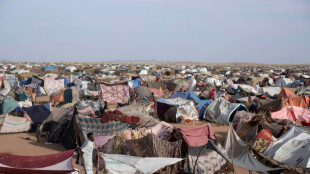 The Sudanese who told the world what happened in El-Fasher
The Sudanese who told the world what happened in El-Fasher
-
Three things we learned from the Sao Paulo Grand Prix

-
 ASC acquire majority share in Atletico Madrid
ASC acquire majority share in Atletico Madrid
-
Ferrari boss tells Hamilton, Leclerc to drive, not talk

-
 Bank of England seeks to 'build trust' in stablecoins
Bank of England seeks to 'build trust' in stablecoins
-
China suspends 'special port fees' on US vessels for one year

-
 French court frees ex-president Sarkozy from jail pending appeal
French court frees ex-president Sarkozy from jail pending appeal
-
No link between paracetamol and autism, major review finds

-
 Typhoon Fung-wong floods Philippine towns, leaves 5 dead in its wake
Typhoon Fung-wong floods Philippine towns, leaves 5 dead in its wake
-
France's Sarkozy says prison a 'nightmare' as prosecutors seek his release

-
 Guinness maker Diageo picks new CEO after US tariffs cloud
Guinness maker Diageo picks new CEO after US tariffs cloud
-
China suspends 'special port fees' on US vessels

-
 US senators take major step toward ending record shutdown
US senators take major step toward ending record shutdown
-
Typhoon Fung-wong leaves flooded Philippine towns in its wake

-
 From Club Med to Beverly Hills: Assinie, the Ivorian Riviera
From Club Med to Beverly Hills: Assinie, the Ivorian Riviera
-
The 'ordinary' Arnie? Glen Powell reboots 'The Running Man'

-
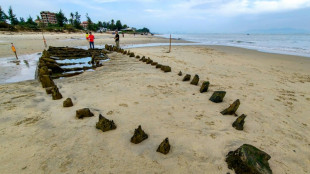 Typhoon exposes centuries-old shipwreck off Vietnam port
Typhoon exposes centuries-old shipwreck off Vietnam port
-
French court to decide if ex-president Sarkozy can leave jail

-
 China lifts sanctions on US units of South Korea ship giant Hanwha
China lifts sanctions on US units of South Korea ship giant Hanwha
-
Japan death row inmate's sister still fighting, even after release
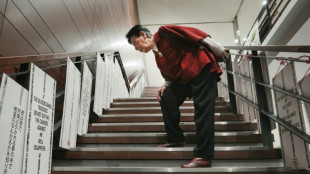

Stressed out: how to measure dangerous heat
In the hottest year on record, with scorching conditions claiming lives from India to Mexico and Greece sweltering in its earliest-ever heatwave, experts are sounding the alarm over heat stress.
The condition kills more people than hurricanes, floods or any other climate-related extreme, but what is heat stress exactly, and how is it measured?
- 'Silent killer' -
Heat stress occurs when the body's natural cooling systems are overwhelmed, causing symptoms ranging from dizziness and headaches to organ failure and death.
It is brought on by prolonged exposure to heat and other environmental factors that work together to undermine the body's internal thermostat and its ability to regulate temperature.
"Heat is a silent killer, because symptoms are not so easily evident. And when these underlying conditions are present, the consequences can be very bad, and even catastrophic," said Alejandro Saez Reale of the World Meteorological Organization (WMO).
Infants, the elderly, people with health problems and outdoor workers are particularly vulnerable. City dwellers surrounded by concrete, brick and other heat-absorbing surfaces also face an elevated risk.
The WMO estimates that heat kills around half a million people a year but says the true toll is not known, and could be 30 times higher than is currently recorded.
As climate change makes heatwaves longer, stronger and more frequent, people across the planet will be increasingly exposed to conditions that test the limits of human endurance.
- More than a maximum -
Temperature might be the most widely used and easily understood weather reading, but headline-catching "maximum highs" do not fully tell how heat might affect the human body.
For example, the same temperature can feel very different in one place versus another: 35 degrees Celsius (95 Fahrenheit) feels much different in the dry heat of the desert versus the humid climes of a jungle.
To build a more complete picture, scientists consider a host of factors including temperature but also humidity, wind speed, clothing, direct sunshine, and even the amounts of concrete or greenery in the area.
All these play a big role in how the body perceives, and most importantly responds to, extreme heat.
There are many ways to measure heat stress, some of which are decades old, but all try to boil down different environmental readings into a single number or graph.
- 'Feels like' -
One of the oldest methods is known as wet-bulb temperature, a useful gauge in situations where the thermometer reading may not seem too extreme but when combined with humidity becomes unbearable, even lethal.
Just six hours exposed to 35 degrees Celsius with 100 percent humidity is enough to kill a healthy person, scientists said in 2023. Above this limit, sweat cannot evaporate off the skin, and the body overheats and expires.
Copernicus, the EU's climate monitor, uses the Universal Thermal Climate Index (UTCI), which considers temperature and humidity but also wind, sunshine and radiated heat to rank heat stress levels from moderate to extreme.
Extreme heat stress, as judged by this index, is a "feels like" temperature of 46 Celsius and above, at which point it is necessary to take action to avoid health risks.
The Heat Index, used by the US National Weather Service, offers an "apparent temperature" based on heat and humidity in the shade, and a colour-coded graph denoting the likelihood of illness from exposure.
Canada has developed the Humidex rating, which combines heat and humidity into one number to reflect the "perceived temperature" and presents the associated risk in a four-step "guide to summer comfort" chart.
- Limitations -
Other examples of "thermal stress" indices include the Tropical Summer Index, Predicted Heat Strain and the mean radiant temperature.
They are not without limitations, and heatwave expert John Nairn said some measures worked better in some climates than others.
"It's not the same all around the world, about the way you approach it," Nairn told AFP.
The UTCI, for example, is excellent at reading heat stress in Germany, where it was first developed, but "a very poor measure" in global south countries, he said.
"It saturates and over-measures far too much. And it would over-alert for those communities who are chronically exposed to heat," said Nairn, who has advised governments and the WMO on heatwave policy.
These locations might get better heat stress readings using wet-bulb temperature, he said.
These indices also do not consider the impact of heat beyond health, he said, even though a heatwave could strand trains or overload air-conditioners.
"If your heat challenge is such that it gets to a level where your infrastructure is not going to operate, and it starts failing, that will have a return on humans no longer being protected," Nairn said.
Y.Kobayashi--AMWN


